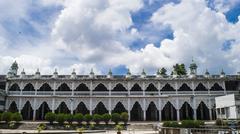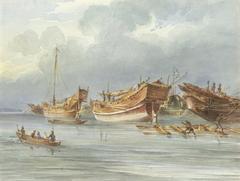Central Shaheed Minar in Chittagong: Visiting Hours, Tickets, and Historical Significance
Date: 14/06/2025
Introduction
The Central Shaheed Minar in Chittagong stands as a poignant tribute to the martyrs of the 1952 Bengali Language Movement, a watershed event that forged Bangladesh’s national identity and cultural heritage. Situated within the University of Chittagong campus, this monumental site not only memorializes those who sacrificed their lives for linguistic rights but also serves as a vibrant hub for cultural, educational, and community activities. Its design, echoing the original Dhaka monument by Hamidur Rahman and Novera Ahmed, is rich with symbolism—depicting a mother mourning her lost children, and representing unity, resilience, and the enduring spirit of the Bengali people (The Financial Express; Pineqone).
Visitors to the Central Shaheed Minar immerse themselves in the historical narrative of the Language Movement, experiencing a site that has evolved into a beacon of remembrance, reflection, and cultural pride. The monument’s open-air architecture, symbolic columns, and landscaped surroundings foster an atmosphere of collective memory and community gathering, particularly during annual commemorations such as International Mother Language Day on February 21 (UN.org; Evendo).
This guide delivers detailed visitor information—covering hours, ticketing (free entry), accessibility, transportation, travel tips, and nearby attractions—while also highlighting ongoing preservation efforts and the monument’s pivotal role in Chittagong’s cultural landscape (The Daily Star).
Table of Contents
- Origins and Symbolism of Central Shaheed Minar
- The Language Movement and Legacy
- Cultural and Educational Role
- Visitor Information
- Architectural Features
- Preservation and Community Engagement
- Annual Observances and Traditions
- FAQs
- Conclusion and Further Resources
Origins and Symbolism of Central Shaheed Minar
The Chittagong Central Shaheed Minar is a regional reflection of the national monument in Dhaka, rooted in the historic events of February 21, 1952. During the Language Movement, students and activists in Dhaka and across what was then East Pakistan protested for Bengali to be recognized as a state language. The tragic deaths of these protestors led to the first Shaheed Minar, hastily built on February 23, 1952, in Dhaka as a symbol of collective mourning and resistance (The Financial Express).
The monument’s design—vertical columns on a raised platform—was later refined by Hamidur Rahman and Novera Ahmed. The motif of a grieving mother and her children is echoed in the Chittagong version, emphasizing loss, hope, and the unbreakable bond of community. Modernist abstraction, clean lines, and open spaces invite reflection and commemorate the power of language as an instrument of identity and liberation (Pineqone).
The Language Movement and Legacy
The Language Movement was a defining moment for Bangladesh, culminating in the recognition of Bengali as a state language in 1956. The Shaheed Minar thus stands as a powerful symbol of the fight for cultural and linguistic rights, resilience in the face of oppression, and the unity of the Bangladeshi people (Academia.edu). Its legacy is celebrated annually on International Mother Language Day—an event now observed worldwide since UNESCO’s 1999 recognition (UN.org).
Cultural and Educational Role
The Central Shaheed Minar is a vibrant center for cultural and educational activities. It hosts a range of events throughout the year, including poetry recitations, musical performances, and academic discussions. On International Mother Language Day, the site becomes the heart of commemorations, with thousands gathering for the “Probhat Feri” (dawn procession), flower-laying ceremonies, and cultural programs that reinforce the values of linguistic diversity and heritage (Pineqone).
The monument also serves as an outdoor classroom for students and visitors, fostering social awareness around minority languages and cultural rights (Academia.edu).
Visitor Information
Visiting Hours
- Open Daily: 8:00 AM – 6:00 PM
- Check with the University of Chittagong or local tourism offices for updates during special events or holidays.
Admission and Tickets
- Entry: Free of charge
- No tickets are required; donations may be welcomed during major events to support maintenance.
Accessibility
- Wheelchair Access: Ramps and open spaces accommodate visitors with mobility needs.
- Facilities: Restrooms and shaded seating available on campus.
How to Get There
- Location: University of Chittagong campus, approximately 10 km from Chittagong city center.
- Transport: Taxi, ride-sharing services, local buses, or CNG auto rickshaw. Parking is available near the campus entrance.
Travel Tips
- Best Time to Visit: Early mornings or weekdays for a quieter experience; February 21 for vibrant cultural events.
- Dress Code: Modest, respectful attire is recommended.
- Photography: Allowed—morning and late afternoon offer the best lighting.
- What to Bring: Comfortable shoes, sun protection, bottled water.
Nearby Attractions
- Foy’s Lake
- Patenga Beach
- Ethnological Museum
- War Cemetery
These sites enhance your understanding of Chittagong’s cultural and historical diversity (triphobo.com).
Architectural Features
The monument’s minimalist design uses white concrete or stone, signifying purity and peace. Upright pillars of varying heights evoke the mother and her children, with the central column symbolizing the Bengali language. Open-air layouts, geometric symmetry, and landscaped gardens encourage reflection and collective gathering. Strategic lighting at night transforms the site into a luminous beacon of remembrance (The Financial Express).
Preservation and Community Engagement
Historical Preservation and Challenges
Preservation efforts have overcome environmental wear, urban development pressures, and periods of controversy. The original Chittagong Shaheed Minar was dismantled in 2018 to make way for a new cultural complex. During reconstruction, a temporary site ensured the continuity of commemorative traditions (The Daily Star).
Recent public feedback led to the monument’s redesign for greater visibility and processional access, with improvements ongoing. Local authorities, cultural activists, and community groups play vital roles in safeguarding the site through advocacy, maintenance, and public engagement (The Daily Star).
Community Participation
Grassroots activism shaped the monument’s reconstruction and continues to drive enhancements. Annual events, particularly International Mother Language Day, see widespread community participation, reinforcing the Shaheed Minar’s role as a unifying force (Evendo).
Digital engagement through social media, virtual tours, and educational campaigns has expanded the monument’s reach, engaging younger generations and a global audience.
Annual Observances and Traditions
- International Mother Language Day (February 21):
The largest gathering, with dawn processions, floral tributes, and cultural programs. - Other National Holidays:
Independence Day (March 26), Victory Day (December 16), and various cultural festivals. - Rituals:
Visitors often remove shoes before stepping onto the main platform and lay flowers as a sign of respect.
FAQs
Q: What are the visiting hours for the Central Shaheed Minar in Chittagong?
A: Daily, 8:00 AM – 6:00 PM.
Q: Is there an entry fee?
A: No, entry is free.
Q: Are guided tours available?
A: Yes, especially around major commemorations. Check with the University of Chittagong or local cultural groups.
Q: How do I get there from Chittagong city?
A: By taxi, ride-sharing, bus, or CNG auto rickshaw.
Q: Is the site accessible for people with disabilities?
A: Yes, the site includes ramps and widened pathways.
Q: What are the best times to visit?
A: Weekdays for a quieter atmosphere; February 21 for cultural events.
Conclusion and Further Resources
The Central Shaheed Minar in Chittagong is more than a monument—it is a living testament to Bangladesh’s struggle for linguistic and cultural identity. Its evocative design, rich program of cultural events, and accessible facilities make it an essential destination for locals and travelers alike. Ongoing community engagement and preservation efforts ensure its continued relevance as a symbol of unity, resilience, and pride.
Enhance your visit by exploring nearby attractions and participating in commemorations. For up-to-date travel tips, event schedules, and visitor services, download the Audiala app and engage with local cultural organizations.
References and Further Reading
- Turbulent History of Shaheed Minar, The Financial Express
- Central Shaheed Minar Chittagong University, Pineqone
- International Mother Language Day, United Nations
- Central Shaheed Minar University of Chittagong, Evendo
- Port City Residents Pay Tribute Central Shaheed Minar After 4 Years, The Daily Star

